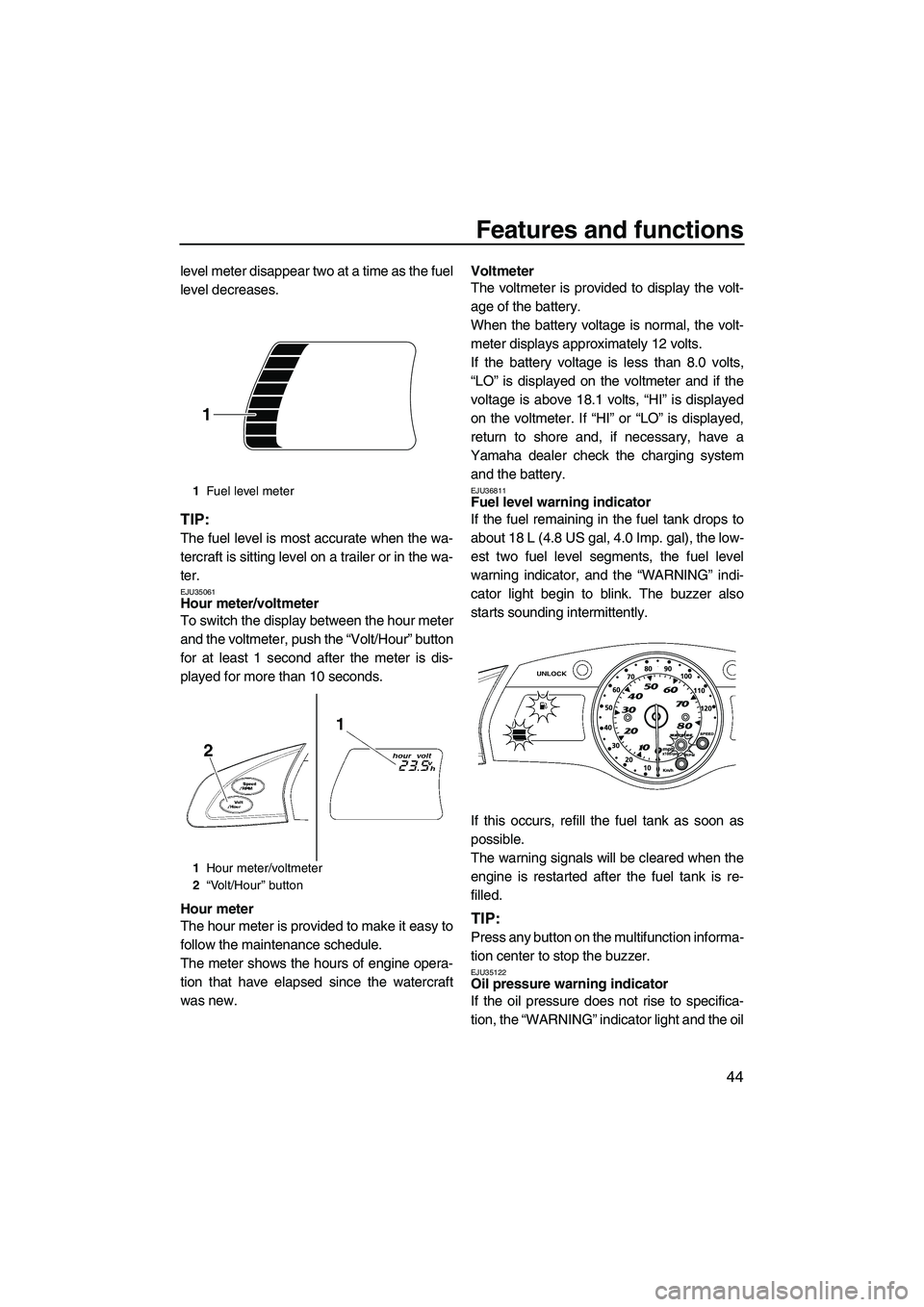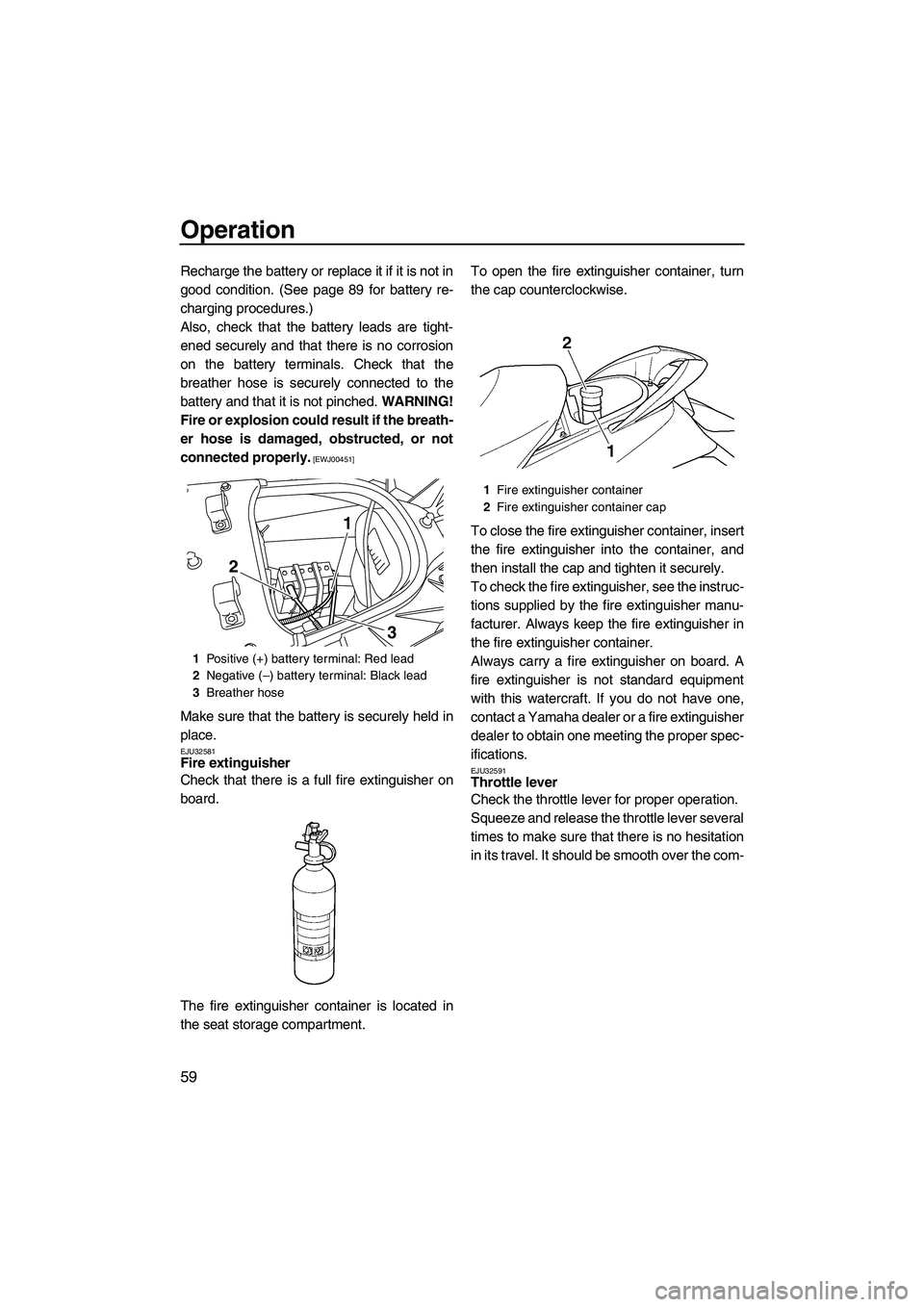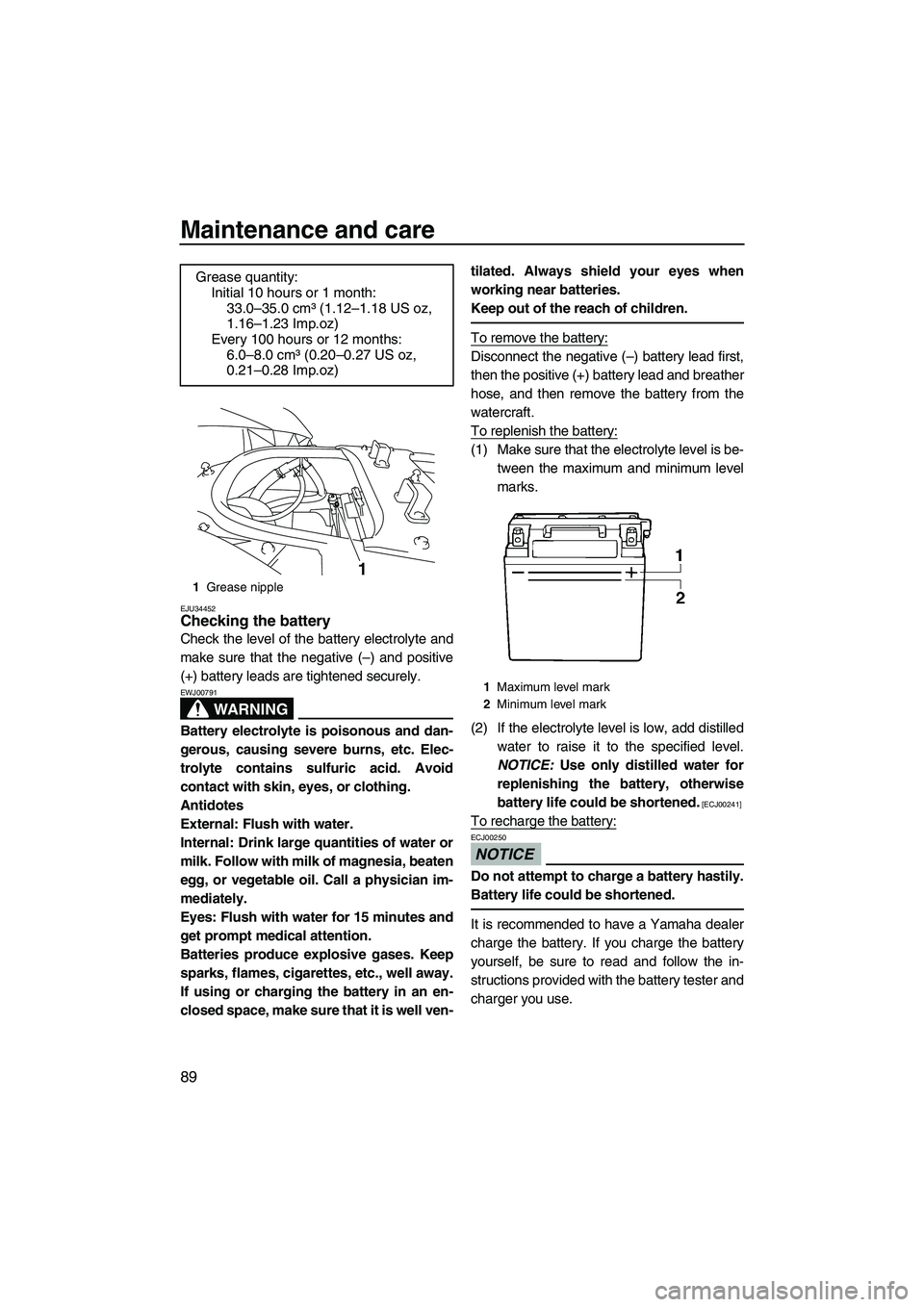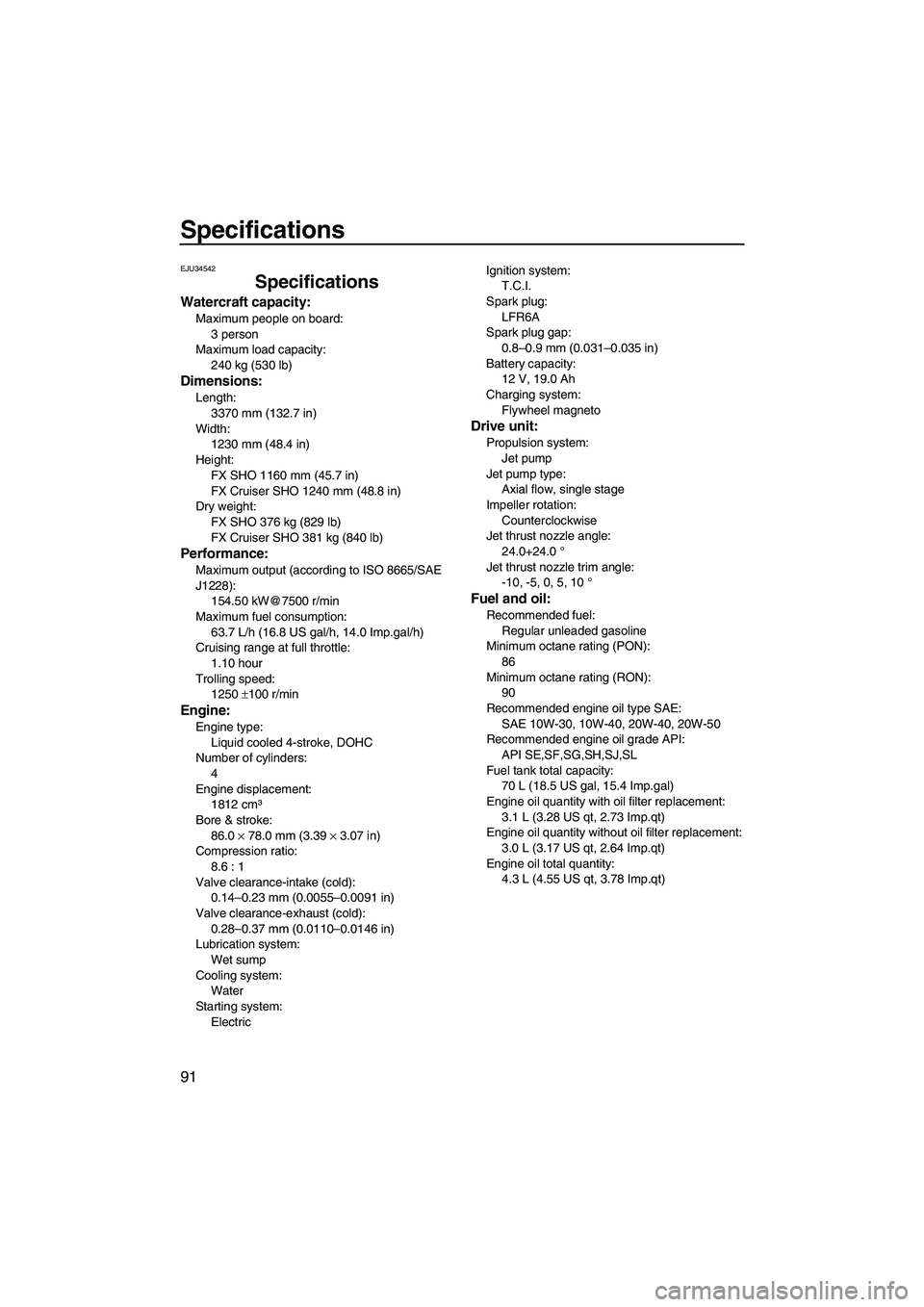charging YAMAHA FX SHO 2009 Owners Manual
[x] Cancel search | Manufacturer: YAMAHA, Model Year: 2009, Model line: FX SHO, Model: YAMAHA FX SHO 2009Pages: 108, PDF Size: 8.04 MB
Page 51 of 108

Features and functions
44
level meter disappear two at a time as the fuel
level decreases.
TIP:
The fuel level is most accurate when the wa-
tercraft is sitting level on a trailer or in the wa-
ter.
EJU35061Hour meter/voltmeter
To switch the display between the hour meter
and the voltmeter, push the “Volt/Hour” button
for at least 1 second after the meter is dis-
played for more than 10 seconds.
Hour meter
The hour meter is provided to make it easy to
follow the maintenance schedule.
The meter shows the hours of engine opera-
tion that have elapsed since the watercraft
was new.Voltmeter
The voltmeter is provided to display the volt-
age of the battery.
When the battery voltage is normal, the volt-
meter displays approximately 12 volts.
If the battery voltage is less than 8.0 volts,
“LO” is displayed on the voltmeter and if the
voltage is above 18.1 volts, “HI” is displayed
on the voltmeter. If “HI” or “LO” is displayed,
return to shore and, if necessary, have a
Yamaha dealer check the charging system
and the battery.
EJU36811Fuel level warning indicator
If the fuel remaining in the fuel tank drops to
about 18 L (4.8 US gal, 4.0 Imp. gal), the low-
est two fuel level segments, the fuel level
warning indicator, and the “WARNING” indi-
cator light begin to blink. The buzzer also
starts sounding intermittently.
If this occurs, refill the fuel tank as soon as
possible.
The warning signals will be cleared when the
engine is restarted after the fuel tank is re-
filled.
TIP:
Press any button on the multifunction informa-
tion center to stop the buzzer.
EJU35122Oil pressure warning indicator
If the oil pressure does not rise to specifica-
tion, the “WARNING” indicator light and the oil
1Fuel level meter
1Hour meter/voltmeter
2“Volt/Hour” button
1
UF1W71E0.book Page 44 Tuesday, June 24, 2008 11:46 AM
Page 66 of 108

Operation
59
Recharge the battery or replace it if it is not in
good condition. (See page 89 for battery re-
charging procedures.)
Also, check that the battery leads are tight-
ened securely and that there is no corrosion
on the battery terminals. Check that the
breather hose is securely connected to the
battery and that it is not pinched. WARNING!
Fire or explosion could result if the breath-
er hose is damaged, obstructed, or not
connected properly.
[EWJ00451]
Make sure that the battery is securely held in
place.
EJU32581Fire extinguisher
Check that there is a full fire extinguisher on
board.
The fire extinguisher container is located in
the seat storage compartment.To open the fire extinguisher container, turn
the cap counterclockwise.
To close the fire extinguisher container, insert
the fire extinguisher into the container, and
then install the cap and tighten it securely.
To check the fire extinguisher, see the instruc-
tions supplied by the fire extinguisher manu-
facturer. Always keep the fire extinguisher in
the fire extinguisher container.
Always carry a fire extinguisher on board. A
fire extinguisher is not standard equipment
with this watercraft. If you do not have one,
contact a Yamaha dealer or a fire extinguisher
dealer to obtain one meeting the proper spec-
ifications.EJU32591Throttle lever
Check the throttle lever for proper operation.
Squeeze and release the throttle lever several
times to make sure that there is no hesitation
in its travel. It should be smooth over the com-
1Positive (+) battery terminal: Red lead
2Negative (–) battery terminal: Black lead
3Breather hose
3
1
2
1Fire extinguisher container
2Fire extinguisher container cap
UF1W71E0.book Page 59 Tuesday, June 24, 2008 11:46 AM
Page 96 of 108

Maintenance and care
89
EJU34452Checking the battery
Check the level of the battery electrolyte and
make sure that the negative (–) and positive
(+) battery leads are tightened securely.
WARNING
EWJ00791
Battery electrolyte is poisonous and dan-
gerous, causing severe burns, etc. Elec-
trolyte contains sulfuric acid. Avoid
contact with skin, eyes, or clothing.
Antidotes
External: Flush with water.
Internal: Drink large quantities of water or
milk. Follow with milk of magnesia, beaten
egg, or vegetable oil. Call a physician im-
mediately.
Eyes: Flush with water for 15 minutes and
get prompt medical attention.
Batteries produce explosive gases. Keep
sparks, flames, cigarettes, etc., well away.
If using or charging the battery in an en-
closed space, make sure that it is well ven-tilated. Always shield your eyes when
working near batteries.
Keep out of the reach of children.
To remove the battery:
Disconnect the negative (–) battery lead first,
then the positive (+) battery lead and breather
hose, and then remove the battery from the
watercraft.
To replenish the battery:
(1) Make sure that the electrolyte level is be-
tween the maximum and minimum level
marks.
(2) If the electrolyte level is low, add distilled
water to raise it to the specified level.
NOTICE: Use only distilled water for
replenishing the battery, otherwise
battery life could be shortened.
[ECJ00241]
To recharge the battery:
NOTICE
ECJ00250
Do not attempt to charge a battery hastily.
Battery life could be shortened.
It is recommended to have a Yamaha dealer
charge the battery. If you charge the battery
yourself, be sure to read and follow the in-
structions provided with the battery tester and
charger you use. Grease quantity:
Initial 10 hours or 1 month:
33.0–35.0 cm³ (1.12–1.18 US oz,
1.16–1.23 Imp.oz)
Every 100 hours or 12 months:
6.0–8.0 cm³ (0.20–0.27 US oz,
0.21–0.28 Imp.oz)
1Grease nipple
1
1Maximum level mark
2Minimum level mark
UF1W71E0.book Page 89 Tuesday, June 24, 2008 11:46 AM
Page 98 of 108

Specifications
91
EJU34542
Specifications
Watercraft capacity:
Maximum people on board:
3 person
Maximum load capacity:
240 kg (530 lb)
Dimensions:
Length:
3370 mm (132.7 in)
Width:
1230 mm (48.4 in)
Height:
FX SHO 1160 mm (45.7 in)
FX Cruiser SHO 1240 mm (48.8 in)
Dry weight:
FX SHO 376 kg (829 lb)
FX Cruiser SHO 381 kg (840 lb)
Performance:
Maximum output (according to ISO 8665/SAE
J1228):
154.50 kW@7500 r/min
Maximum fuel consumption:
63.7 L/h (16.8 US gal/h, 14.0 Imp.gal/h)
Cruising range at full throttle:
1.10 hour
Trolling speed:
1250 ±100 r/min
Engine:
Engine type:
Liquid cooled 4-stroke, DOHC
Number of cylinders:
4
Engine displacement:
1812 cm³
Bore & stroke:
86.0 × 78.0 mm (3.39 × 3.07 in)
Compression ratio:
8.6 : 1
Valve clearance-intake (cold):
0.14–0.23 mm (0.0055–0.0091 in)
Valve clearance-exhaust (cold):
0.28–0.37 mm (0.0110–0.0146 in)
Lubrication system:
Wet sump
Cooling system:
Water
Starting system:
ElectricIgnition system:
T.C.I.
Spark plug:
LFR6A
Spark plug gap:
0.8–0.9 mm (0.031–0.035 in)
Battery capacity:
12 V, 19.0 Ah
Charging system:
Flywheel magneto
Drive unit:
Propulsion system:
Jet pump
Jet pump type:
Axial flow, single stage
Impeller rotation:
Counterclockwise
Jet thrust nozzle angle:
24.0+24.0 °
Jet thrust nozzle trim angle:
-10, -5, 0, 5, 10 °
Fuel and oil:
Recommended fuel:
Regular unleaded gasoline
Minimum octane rating (PON):
86
Minimum octane rating (RON):
90
Recommended engine oil type SAE:
SAE 10W-30, 10W-40, 20W-40, 20W-50
Recommended engine oil grade API:
API SE,SF,SG,SH,SJ,SL
Fuel tank total capacity:
70 L (18.5 US gal, 15.4 Imp.gal)
Engine oil quantity with oil filter replacement:
3.1 L (3.28 US qt, 2.73 Imp.qt)
Engine oil quantity without oil filter replacement:
3.0 L (3.17 US qt, 2.64 Imp.qt)
Engine oil total quantity:
4.3 L (4.55 US qt, 3.78 Imp.qt)
UF1W71E0.book Page 91 Tuesday, June 24, 2008 11:46 AM